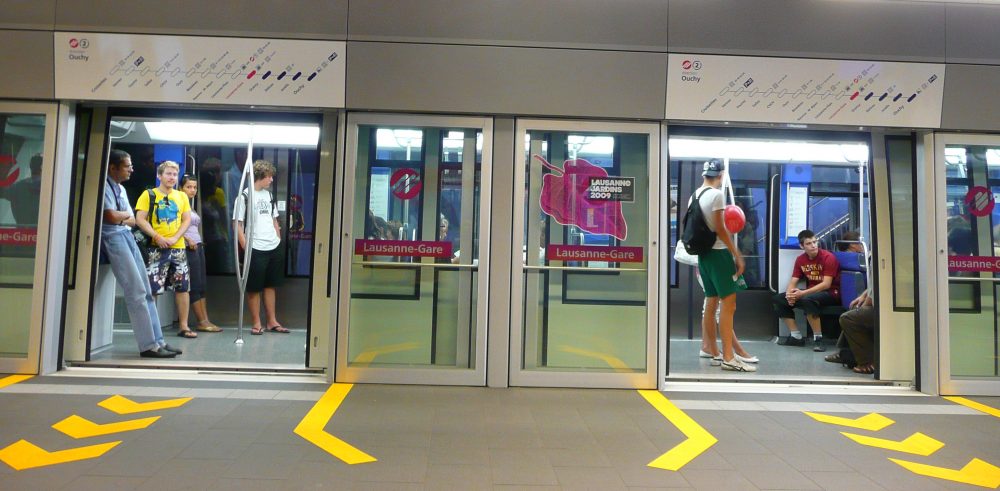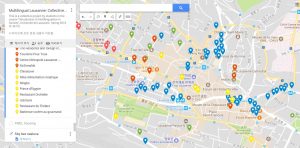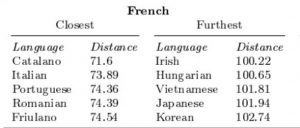Abstract
Asian markets are spreading all around the world in recent years, and so as in Lausanne. This paper aims for an insight to Asian food industries by looking deeper into the linguistic landscape of Lausanne. Using the theoretical framework which includes top-down / bottom up approach and main and secondary language, we set a hypothesis on our own. We thought that French would be presented as the main language, while Asian languages would rather be absent. Data of Linguistic Landscape was taken by taking photos while walking through Lausanne-flon and analyzing reviews from Google maps and trip advisor. The research paper had found that the results did not correspond to the hypothesis. Asian languages were easily found in all the stores we investigated, and some of them were even presented as main language.
- Introduction
This paper was written to find out how the Asian food industry is constructed linguistically in the city center of Lausanne, a francophone city in Switzerland. We’ve been in Lausanne for a few months and realized that food from our home country really takes big part of our lives. So we decided to walk through the streets to see Asian food industries’ language use. Our hypothesis was that there wouldn’t be a lot of Asian languages used, since we had barely seen Asian languages while in Lausanne. In the theoretical framework, we’ll focus on top down/bottom up and main language and secondary language. In the contextualization, we’ll explain why we chose Switzerland, and especially Lausanne flon. Then we’ll talk about methodology, which accompanied taking pictures while on the street, and Trip Advisors and Google reviews for analyzing the distribution of the customers. We described each photo in the result part and made discussion based on that.
- Theoretical framework
It is important to have multilingualism in a country, as it can foster cultural exchange between people and is the main element of cultural diversity. (Lo Bianco, 2010) In order to analyze how multilingualism is incorporated into the city or country, Linguistics Landscape is a tool to do so. Linguistics Landscape, by definition given by Landry and Bourhis (1997), means:
the language of public road signs, advertising billboards, street names, place names, commercial shop signs, and public signs on government buildings combines to form the linguistic landscape of a given territory, region, or urban agglomeration.
Landry and Bourhis have further simplified their meaning of Linguistics Landscape in 2002 to the use of language written in different medium that is shown in the public place. In this research paper, we chose commercial shop signs and advertising billboards as our targets. The followings are the concepts that we have used in writing this research paper: top-down, bottom-up, main language and secondary language.
Top-down vs Bottom-up
Signs could be interpreted as top-down or bottom-up depending on the producer. In this research, we follow the definition given by Ben-Rafael et al, (2006). They mentioned that ‘top down’ items are ‘issued by national and public bureaucracies’, and ‘bottom up’ items as ‘issued by individual social actors’, and those social actors include shop owners and companies.
Main Language and Secondary Language
Jasone Cenoz et al said in 2006 that ‘the linguistic landscape reflects the relative power and status of the different languages in a specific sociolinguistic context’. This relative power can be shown how languages are displayed. We analyzed the language dominant by dividing. it into two types: main language and secondary language. Main languages are those written first, bigger, colored or with a bold while secondary language serves as an additional role to this, with a less significance.
- Contextualisation
There is no doubt that Switzerland is a very globalized and multilingual country. They have four official languages (French, German, Italian, Romansh), and 24.6% of the permanent population is foreigners. Lausanne, located in a francophone region, is the fourth biggest in city in this country, following Zurich, Geneva, and Basel.
The figures prove how globalized Lausanne is. The City Statistics Portraits made by DFI in 2017 tells that among its 135,629 inhabitants, 42.9% of the people are permanent foreign residence population, and permanent foreign residence population from Non-EU countries accounts for 15.4% of the whole population. This is a high proportion considering the fact that permanent foreign residence population takes up 24.6% and Non-EU permanent residence accounts for only 8.3% of the whole Switzerland population.
Although Asia is not significant in figures when it comes to permanent residence, it takes up huge part in tourism. According to Swiss tourism figure 2015, out of 19,576,295 of overnight stays made by foreigners, 4,741,090 of them were from Asia, which was biggest in numbers in continental analysis. China (Hongkong included) accounted for 1,519,100, 4th biggest number in country analysis.
There are some factors that made Lausanne multinational and multilingual region. First, it is geographically located near France and Italy, especially France just being one lake away. Secondly, Lausanne is the Olympic capital of the world. It has the International Olympic Committee, and that led a lot of other international sport federations to move its headquarters to Lausanne. It also has a lot of higher educational institutions, such as EPFL, UNIL, Lausanne Hotel School and IMD. Furthermore, it has also been a tourist city since 18th century, attracting tourists with its Alps that has been recently discovered back then. Lausanne was therefore able to join an enlarged economic area without being much industrial center back then. However, the influx of the immigrants, Italians in a large number, started to increase with the economic development of Lausanne in 19th century. Therefore, even the big river that goes across the town, the flon, was covered to support the economic development by providing even more space. Like this, geographical, sociopolitical, educational, touristic and economical reasons all drew many foreigners to Lausanne making it multilingual and multinational city.
In this globalized city of Lausanne, we particularly focused on the district of the flon. As we mentioned just before, it has been a center of economic development accompanied by migrant culture that started in 19th century. Even now, it is the must-stop place for foreigners since it is only 10 minutes away from the Gare, where most of the foreigners would start their journey in Lausanne and has population office for foreigners.
Just like flon could be the representation of foreign cultures in Lausanne, it is where Asian culture in Lausanne is most dominant, too. When we searched Asian Restaurants in a Google map in a city of Lausanne, we got a result like this:

<Picture 1> Asian restaurants near Lausanne Flon
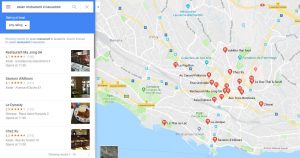
<Picture 2> Asian restaurants in whole Lausanne
Clearly, Asian culture is most clustered around Lausanne flon. We had the similar results for Asian supermarkets as well. Therefore, we decided to go to flon in search of the Asian food industry.
- Methodology
On 19th April, 2018, we searched some Asian restaurant and markets before leaving for flon by using Google maps and set pathway according to that. We walked and took photos of multilingual signs along that way. We took photos of other foreign restaurants as well because we thought it would be interesting to compare them with Asian stores. For analyzing three different usage of Chinese restaurants, we used Google and Trip Advisor review as well.
Before we went on to data collection, we expected French would be dominant language even in an Asian food store because of these reasons. First, it is natural to have French in a French speaking region, and Asian markets are no exception. Also, we thought stores cannot survive if they only appeal to Asian customers since Asian is minority in numbers in Lausanne. They have to localize their service first to appeal to the residents here or add English as well to embrace the tourists as well. Finally, we thought that store owners would expect that Asians inhabiting in Lausanne would already know French. Therefore, we set a hypothesis that the Asian language wouldn’t be easily found.
However, this method had some drawbacks. This method was done in a superficial way, as it didn’t include real conversation with the people. Moreover, as there aren’t any official reviews or statistics of the restaurants, hence our analysis based on the reviews in google map on the restaurant may not be accurate. Furthermore, the lack of data could mean the comprehensiveness of the paper might not be enough.
5.Results
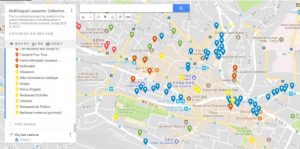
<Picture 3 Collective Google map>The yellow dots are data we used.
So, here’s the photo and explanations of the places we selected. We have six restaurants, and two shops. We have three Chinese restaurants, all differing how they used their language, a Korean restaurant, Italian and Egyptian Restaurant. We have photos of two Asian market, Chinese and Japanese respectively. These stores were produced in a bottom-up way by the store or building owner and all had signs for commercial use. However, they all had communicative usage as well since they were used to give information about the store themselves and products they have. The detailed description of each places will follow with the pictures below.

<Picture 4: Ningbo>
This is a picture of a Chinese restaurant named ‘Ningbo’, which uses Chinese as a main language. It is written bigger with a red color to emphasize it in the menu and the banner. French can be also found below the Chinese character of the menu, but just for explaining the menu.
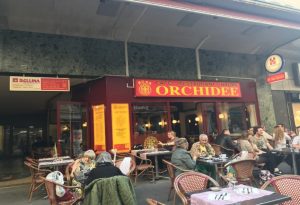
<Picture 5: Restaurant Orchidée>
This is a Chinese restaurant called ‘Restaurant Orchidée’. The main language is French, and the secondary language is Chinese. This is because the name of the restaurant and the menu are mainly in French, with some Chinese as an explanation.


<Picture 6,7: Chinatown>
The two pictures above are from Chinese restaurant called ‘Chinatown’. Out of menu written in French, Chinese, and English, French is main language since it is bolded and emphasized. Also, the opening hours are only written in French.

<Picture 8: Restaurant Coreen>
This is a flyer of the Korean barbecue restaurant in Flon. They used different kinds of language, including Korean, Chinese, and French. However, the interesting thing is that even though it’s a Korean restaurant, they are not using Korean properly. It says it’s ‘한국어 바베큐’, which means ‘Korean language barbecue’, a complete nonsense. You can get this translation when you type in ‘Korean Barbecue’ in the google translator. Therefore, we can infer that this store owner was trying to gain authenticity by using Korean, but that attempt didn’t work out well because of the lack of proper translation.
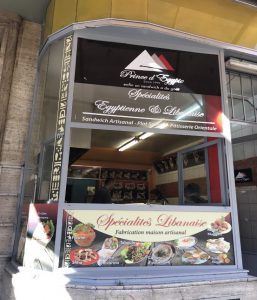
<Picture 9: Prince d’Egypt>
This is an Egyptian restaurant called ‘Prince d’Egypte’. The main language used is French, since the menu and the name of the restaurant is illustrated mostly in French. The only word that is in other language other than French is ‘since’. We were surprised that they didn’t have any Arabic in it, neither in the menu nor the sign of the restaurant, even though it’s an Egyptian restaurant.
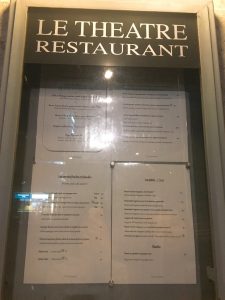
<Picture 10: Le Theatre Restaurant>
This restaurant doesn’t have a lot of explanations in foreign language other then Frehch. The main language here is French and English plays a secondary role explaining the menus. This restaurant had all the other signs only in English.

<Picture 11: Uchitomi>
In ‘Uchitomi’, a Japanese market, Japanese and French are used as a main language. The store banner, price tag and the leaflet are written in Japanese with a French translation below everywhere. The shopkeeper spoke French to non Japanese, and Japanese to Japanese.
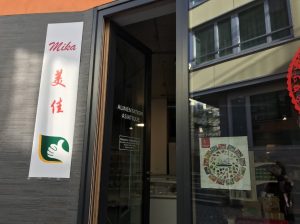
<Picture 12: Mika>
This is an Asian supermarket named ‘Mika Alimentation Asiatique’, the main language is French, as all the price tag are only written in French. Chinese was seen as a secondary language in the banner of the store and decorations. The shopkeeper spoke French to non-Chinese and spoke Chinese to Chinese.
- Discussion
All of the stores that we analyzed produced signs in a bottom up way. This could be why all of the stores had Asian languages in the store. Since they don’t have to be tied with national ideologies, they can use the language they want to because there were no official languages designated for their use. So, they were accompanying Asian languages because they thought it’s their best strategy.
However, as it can be shown from the three Chinese restaurants above, how they used the language differed from the store to store. First, ‘Ningbo’ was using Chinese as a main language. Second, Restaurant Orchidee was using French as a main language, and Chinese as a second. Third restaurant, Chinatown was using French as a main language accompanied by English and Chinese below.
We thought that this difference in language use would bring difference in customers, too. We analyzed people who left google reviews to these restaurants.
| Asian | Non-Chinese | Unknown | Total | % of Asian | |
| Ningbo | 14 | 35 | 1 | 50 | 28% |
| Restaurant Orchidee | 11 | 94 | 1 | 106 | 10.3% |
| Chinatown | 6 | 60 | 3 | 69 | 8.6% |
<Table 1: Analysis of Google reviews>
Even though this google review can’t be full representation of the customer distribution, it showed that how you use your language affects the store’s customer diversity, and probably the owner of the store knew this as well, too. So we thought that this arrangement of languages had relationship with the store’s owner’s intention as well. If he wanted to appeal to the Chinese people living or travelling in Lausanne, he would make Chinese more dominant. These Chinese centered signs would make them feel friendly and give them a signal that the personnel in the store would be Chinese or fluent in Chinese. Therefore, you can get more Chinese customers. However, if the store owner plans to appeal to the locals here, you should have French as a main language since it is a francophone region. That was the case with Restaurant Orchidee, and the percentage of the Asian shows that it is more localized restaurant compared to Ningbo.
However, if the store owner wants to have tourists as the main customer, it is best if he has English menu as well to appeal more to the foreigners, since English acts as a lingua franca in this region. This was also proved by Trip Advisor review, too. Trip Advisor, a website that is usually used by tourists as the name says, is a site which has restaurant reviews for and by the tourists. While Ningbo had only 51 one reviews, Restaurant Orchidee had 75, and Chinatown had 85. It shows that this restaurant, with English menu, attracted most tourists.
| Number of Trip Advisor Review | |
| Ningbo | 51 |
| Restaurant Orchidee | 75 |
| Chinatown | 81 |
<Table 2: Number of Trip Advisor Review>
We expected that the main language used would be French, while English would be used as a secondary language to aid the non-french speakers. However, unlike our expectation, we found that this is not the case with Asian food industries. Asian languages were, even though some differed in extent, spotted in all the Asian food industries, in the menu, price tag and name banner etc. In some cases like the Chinese restaurant ‘Ningbo’ and the Japanese supermarket ‘Uchitomi’, Asian language are even used as the main language, having more importance than French. Role of French was marginalized to supporting or practical purpose, to indicate location of the restaurant for instance.
Surprised with this result, we came up with a few reasons to explain frequent presence of Asian language in this francophone region.
First reason was for marketing. Presenting the home language of the shop can make the shop become more unique and appealing, thus arousing attention of the visitors and broaden the variety of the customers. Furthermore, it can clearly show which country has the shop originated from, and hence prove the authenticity of it. You may doubt its authenticity of an Asian shop that only uses French. However, when you see the shop using its assumed own Asian language, the authenticity of the shop will be stronger. Hence, the attractiveness to the customers will greatly elevate.
Also, it lowers the language barrier of Asians. In Asian countries such as China, Korea, and Japan, it’s not common to encounter French in every day lives. So, they need their own language to help them understand what it is. Also, it’s not easy for them to just guess what the language just by looking at it since they are not linguistically similar. If you see the chart about linguistic distance below, Korean and Japanese has the furthest distance with French. So it is very likely that people from Asia would face difficulty in Lausanne, and therefore the translation in their own language is provided by the store owners who wants them as a customer.
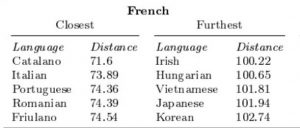
<Table 3: Closest and Furthest Languages>
Furthermore, they could be using their own language to preserve their own identity. By using their own language in a foreign context, they might be trying to remind themselves and show who they are.
However, we were surprised to find out that not all foreign restaurants were accompanying their home language just as the Asian restaurants did. For instance, in the Egyptian restaurant and the Italian restaurant above, there were no sign of Arabic or Italian. We thought that they had different reasons for that. First of all, we thought that Arabic language wouldn’t have much marketing power in Lausanne since not a lot of people from Arabic speaking country live in Lausanne or Switzerland. The report from Federal Statistical Office says that the Iraq has a largest number of the people from Arabic speaking nation in Switzerland, with the number of 8598. Since only the countries with considerable amount of people were mentioned specifically, we could infer that people from Egypt, or other Arabic speaking nations would have much more smaller population than this. This is comparatively small number compared to Asians, which is 154,023.
Also, in the Italian restaurant, they wouldn’t need Italian because of their cultural similarities with Switzerland. Italian is the second closest language to French, and the article from Italian Insider written by Corrison H. in 2016 says that typically learn French as their second foreign language, so it is easier for Italians to understand French without the aid. For some menus like Risotto, they are even spelled same in Italian. Rather, the menu was translated in English, aiming for the travelers. Even though there were no Italians, English could act as a lingua franca and make Italian people understand it. Therefore, there’s no practical reason to put Italian in the Italian restaurant.
- Conclusion
In this research paper, we looked into the construction of Asian food industry in Lausanne. It was found that Asian food industries usually accompany Asian languages, whether it is main or secondary language. The reasons could be attributed to the way it was produced (bottom up), marketing strategy such as gaining authenticity or lowering the language barrier, and presentation of identity.
Though, there were several limitations in this research as well. It might be a being superficial and inaccurate. The study might be difficult to be generalized to whole flon area since there were only 8 stores analyzed. Though, all in all, it is interesting to find out that how Asian food industries were constructed and find out the reasons for that.
Reference
Lo Bianco, J. (2010). The importance of language policies and multilingualism for cultural diversity. International Social Science Journal, 61(199), 37-67. doi
Ben-Rafael, E., Shohamy, E., Hasan Amara, M., & Trumper-Hecht, N. (2006). Linguistic Landscape as Symbolic Construction of the Public Space: The Case of Israel. International Journal Of Multilingualism, 3(1), 7-30.
Jasone C & Durk G. (2006) Linguistic Landscape and Minority Languages. University of the Basque Country, Fryske Academy. International Journal of Multilingualism. Vol 3, No.1. 67
Département fédéral de l’intérieur DFI, 2017, City Statistics portraits 2017: core cities . 7.
FÉDÉRATION SUISSE DU TOURISME. (2015). swiss tourism in figures 2015. 18.
Ville de Lausanne. History. Available at: http://www.lausanne.ch/en/lausanne-en-bref/lausanne-un-portrait/un-portrait/histoire.html Accessed on : 03/06/2018
Olga K. 2013. Language Distance: The Reason Immigrants Have Trouble Assimilating. The Atlantic. Available at: https://www.theatlantic.com/international/archive/2013/05/language-distance-the-reason-immigrants-have-trouble-assimilating/275561/ Accessed on: 03/06/2018.
Corrinna H. 2016. Italy has most language learners, fewest speakers. Italian Insider. Available at: http://www.italianinsider.it/?q=node/3635 Accessed on: 03/06/2018.
